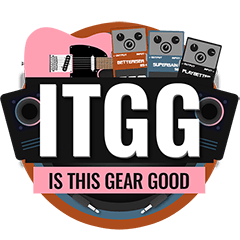Disclaimer: BOSS provided me with this amplifier, and I got to keep it as compensation for my work. However, whether the content is sponsored or not, the company has no say in what I mention in the video/post.
SPECIFICATIONS
Rated Power Output
50 W
Nominal Input Level
- INPUT: -10 dBu (1 MΩ)
- AUX IN: -10 dBu (20 kΩ)
Speaker
30 cm (12 inches) x 1
Controls
- POWER switch
- MASTER knob
- POWER CONTROL switch (STANDBY, 0.5 W, HALF, MAX)
AMPLIFIER
- VARIATION button
- AMP TYPE switch (ACOUSTIC, CLEAN, PUSHED, CRUNCH, LEAD, BROWN)
- GAIN knob
- VOLUME knob
EQUALIZER
- BASS knob
- MIDDLE knob
- TREBLE knob
EFFECT
- BOOSTER button
- MOD button
- FX button
- DELAY button
- REVERB button
- TAP button
- BOOSTER knob
- MOD knob
- FX knob
- DELAY knob
- REVERB knob
TONE SETTING
- CH1 button
- CH2 button
- PANEL button
Indicators
- VARIATION
- BOOSTER
- MOD
- FX
- DELAY
- REVERB
- TAP
- CH1
- CH2
- PANEL
Connectors
- INPUT jack: 1/4-inch phone type
- POWER AMP IN jack: 1/4-inch phone type
- STEREO PHONES jack: Stereo 1/4-inch phone type
- CTL CH1/CH2 SOLO jack: 1/4-inch TRS phone type
- EXP PEDAL jack: 1/4-inch TRS phone type
- AUX IN jack: Stereo miniature phone type
- USB COMPUTER port: USB type‑C®
- BLUETOOTH ADAPTOR SLOT: Bluetooth® Audio MIDI Dual Adaptor
- AC IN jack
Power Consumption
47 W
Accessories
- Owner’s manual
- Power cord
Options (sold separately)
- Footswitch: BOSS FS‑5L, BOSS FS‑6, BOSS FS‑7
- Expression pedal: Roland EV‑5, BOSS EV‑30, BOSS FV‑500L, BOSS FV‑500H
- Bluetooth® Audio MIDI Dual Adaptor (Model BT‑DUAL)
- Amplifier Stand: BAS‑1
SIZE AND WEIGHT (INCLUDES HANDLE AND RUBBER FEET)
- Width: 470 mm (18‑9⁄16 inches)
- Depth: 238 mm (9‑3⁄8 inches)
- Height: 398 mm (15‑11⁄16 inches)
- Weight: 11.6 kg (25 lbs 10 oz)
What Is the BOSS Katana Gen 3 Amplifier?
BOSS Katana Gen 3 is a solid‑state guitar amplifier designed for practice, gigs, and home recording. It comes with six amp characters, a selection of effects, and clever connectivity options for practice, home recording, and live performance.
First Impressions
I’m not new to the Katana series of amplifiers, so I was already familiar with what to expect. I find the weight of the amp (11.6 kg) very manageable, and everything feels well‑built and solid—exactly what I’ve come to expect from BOSS.
There’s no steep learning curve or initial setup; you literally just plug in your guitar, attach a power cable, and start jamming. I like how much you can do right from the control panel: all the amp characters sound great, and it takes mere seconds to add reverb and delay.
The amp feels dynamic and “real” to play. I really like how it reacts when I pick lightly and then transitions smoothly to a more distorted sound as I pick more aggressively.
What Is It Like to Use?
I used this amp in two main scenarios 98% of the time: jamming and practicing in my living room, and playing during band rehearsals and live shows.
As a practice tool, it is fantastic—you can achieve many different tones directly from the amp’s control panel, no matter what music style you play. Similar to the tube amps I grew up with, the Katana reacts to different guitars as expected, and I often found myself getting lost in the tones and just having fun.
I also had the chance to use the amp live; I used it during two band practices and one live set. To keep things simple, I paired my pedalboard with the Katana, which consisted basically of two overdrives. I added some reverb, and I was good to go.
At our church, we have a silent stage—meaning we run everything DI (direct input) to the front-of-house—so I decided to use the headphone output on the back of the amp. The sound I got that way was fine, although I did wish for more options to adjust the impulse response of the line out. There was a lot of high‑end “shizzle” coming into my in‑ears that had to be tamed by the front-of-house. After that adjustment, I was pretty happy with my tones.
I initially planned to use the “Pushed” channel as a pedal platform, but I found that it became too distorted even with just a slight overdrive. During soundcheck, I switched to the clean channel, and that worked perfectly. In my experience, you need to spend some time learning how the Katana reacts to each of your pedals; once you have the perfect settings for every drive pedal, you’re good to go.
Is the BOSS Katana 50 Gen 3 Good?
For the money, this amp is ridiculously good. It is simple to use yet very versatile. It’s a great practice tool, but you can also use it live. And when you want to record, you can just connect it to your computer via USB. The tones range from very decent to great, and the selection of effects is broad enough to satisfy most guitar players’ needs.
The only drawback I found was the limited footswitch options for this amplifier. For the Katana Gen 3 50 model I had, the only available BOSS footswitch is the FS‑6, which isn’t nearly as useful as the standard GA‑FC with its four footswitches. However, the Katana Gen 3 50 EX, Gen 3 100, and Gen 3 100/212 models support it, which I find confusing.
Overall, I really enjoyed playing this amp, and I recommend it despite its minor quirks.
If you want to get your own BOSS Katana Gen 3, you can use the affiliate links here:
Thomann: https://www.thomann.de/fi/thlpg_pfdici1z4p.html
Sweetwater: https://sweetwater.sjv.io/gOAy22

Leave a Reply